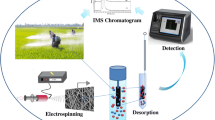Abstract
An electrospun nanofiber containing a molecularly imprinted polymer (MIP) was fabricated by electrospinning and employed as a sorbent for the removal of nickel-5,10,15,20-tetraphenylporphine (NTPP) from organic media. Three different PET/PEI-based molecularly imprinted nanofibers (MIN) were prepared in order to evaluate the impact of the template on the affinity of recognition for NTPP. ICP-OES analysis showed that the NTPP adsorption capacity increased as the molar ratio of NTPP to styrene was increased from 1:1 to 3:1. The optimal ratio of template to functional monomer which yielded the best specific affinity and the highest recovery (99.9 %) was 3:1. The degree of adsorption of NTPP attained with the MIN was much higher than that achieved with the non-imprinted nanofiber (NIN). When the fiber masses were 10, 20, and 30 mg, 40.4, 60.2, and 99.9 %, respectively, of the NTPP was bound by the MIN without overloading the active sites. The corresponding values for the NIN were 12, 15, and 18 %, respectively. Furthermore, the MIN showed remarkable stability in relation to reusability, as it could be reused nine times without any loss in performance. The accuracy of the method was validated by analyzing the certified reference material (CRM) NIST SRM 1634c (Trace Metals in Residual Fuel Oil), and the concentration of NTPP in the CRM was found to be 17.64 mg/kg, which was within the error associated with the certified value of 17.54 mg/kg. The MIN was therefore found to be a selective sorbent that is well suited for handling trace metals in organic media.









Similar content being viewed by others
References
Pepper AS, Corvi PJ (1995) Simple kinetic models of petroleum formation. Part III: modelling an open system. Mar Pet Geol 12:417–452
Price LC, Clayton JL (1992) Extraction of whole versus ground source rocks: fundamental petroleum geochemical implications including oil-source rock correlation. Geochim Cosmochim Acta 56:1213–1222
Baker LF, Ciborowski JJH, Mackinnon MD (2012) Petroleum coke and soft tailings sediment in constructed wetlands may contribute to the uptake of trace metals by algae and aquatic invertebrates. Sci Total Environ 414:177–186
Walls WD (2010) Petroleum refining industry in China. Energy Policy 38:2110–2115
Guo A, Lin X, Liu D, Zhang X, Wang Z (2012) Investigation on shotcoke-forming propensity and controlling of coke morphology during heavy oil coking. Fuel Process Technol 104:332–342
Ohuchi T, Muehlenbachs K, Steer J, Chambers A (1995) Insights into coal solubilisation during coal- bitumen coprocessing as monitored by 13C/12C ratios. Fuel Process Technol 41:101–124
Jafari MT, Badihi Z, Jazan E (2012) A new approach of determine salicylic acid in human urine and blood plasma based on negative electrospray ion mobility spectrometry after selective separation using a molecular imprinted polymer. Talanta 99:520–526
Zang H, Wang Y, Liu X, Kong J, Nie C (2012) Preparation of molecular imprinted polymers using bi-functional monomer and bi-crosslinker for solid phase extraction of rutin. Talanta 93:172–181
Sharma PS, D’Souza F, Kutner W (2012) Molecular imprinting for selective chemical sensing of hazardous compounds and drugs of abuse. TrAC Trends Anal Chem 34:59–77
Bhardwaj N, Kundu SC (2010) Electrospinning: a fascinating fiber fabrication technique. Biotechnol Adv 28:325–347
Kayaci F, Uyar T (2012) Electrospun zein nanofibers incorporating cyclodextrins. Carbohydr Polym 90:558–568
Agarwal S, Wendorff JH, Greiner A (2008) Use of electrospinning technique for biomedical applications. Polymer 49:5603–5621
Yoshimatsu K, Ye L, Lindberg J, Chronakis IS (2008) Selective molecular adsorption using electrospun nanofiber affinity membranes. Biosens Bioelectron 23:1208–1215
Yang Y, Lai EPC (2010) An investigation of porous structure in molecularly imprinted polymer for sensor development: non-linear fluorescence quenching of 17β-estradiol bound inside MIP submicron particles by sodium nitrite and methacrylamide. J Photochem Photobiol A Chem 213:123–128
Yoshikawa M, Tanioka A, Matsumoto H (2011) Molecularly imprinted nanofiber membranes. Curr Opin Chem Eng 1:18–26
Nirmala R, Kalpana D, Jeong JW, Oh HJ, Lee JH, Navamathavan R, Lee YS, Kim HY (2011) Multifunctional baicalein blended poly(vinyl alcohol) composite nanofibers via electrospinning. Colloids Surf A 384:605–611
Tom LA, Schneck NA, Walter C (2012) Improving the imprinting effect by optimizing template:monomer:cross-linker ratios in a molecularly imprinted polymer for sulfadimethoxine. J Chromatogr B 909:61–64
Acknowledgments
The authors would like to express their sincere thanks to the African Network for Analytical Chemists (SEANAC) and South African Coal and Oil Ltd. (Sasol) for the funding. We would also like to acknowledge the Department of Chemistry, Rhodes University, for facilities.
Author information
Authors and Affiliations
Corresponding author
Rights and permissions
About this article
Cite this article
Awokoya, K.N., Moronkola, B.A., Chigome, S. et al. Molecularly imprinted electrospun nanofibers for adsorption of nickel-5,10,15,20-tetraphenylporphine (NTPP) in organic media. J Polym Res 20, 148 (2013). https://doi.org/10.1007/s10965-013-0148-y
Received:
Accepted:
Published:
DOI: https://doi.org/10.1007/s10965-013-0148-y




